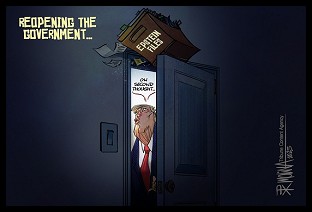Blogged by John Gideon, VotersUnite.Org
A Press Release, which is copied in full on the other side of the fold, was just received from Steven Hertzberg, the Project Director of Election Science Institute that exposes the fact that in September election workers in Cuyahoga County, Ohio put every Diebold memory card into laptop computers in order to archive election information. These laptops were found laying around the office and, in some cases, were even brought from home. There is no way to know how many viruses may have now been transferred from these laptops to the memory cards. Luckily this incident was caught on video tape.
This failure on the part of county election officials is exactly the type of failure that Diebold has claimed over and over again cannot happen. In the new release, Prof. Edward Felton of Princeton University and the recent Diebold TS hack, says:
The press release from Princeton and the Election Science Institute is posted in full below...
Ed Felten, Princeton University
Steven Hertzberg, Election Science Institute
For Immediate Release: Thursday, November 02, 2006
Cuyahoga County Ohio Possibly Exposed Election System to Computer Virus
The memory cards that will be used to store votes on Election Day in Cuyahoga County, Ohio were stuck into ordinary laptop computers in September, possibly exposing the county’s election system to a virus infection. This serious security lapse was caught on video through the efforts of Cleveland resident Adele Eisner and Cleveland-area filmmaker Jeffrey Kirkby, who has graciously made his raw footage available on the Internet for personal viewing at:
http://homepage.mac.com/...nch/iMovieTheater87.html
Just one month ago a Princeton evoting study (available at http://itpolicy.princeton.edu/voting) showed that the memory cards used in Diebold touchscreen voting systems could carry computer viruses that would infect voting machines and steal votes on the infected machines.
“Diebold has repeatedly stated that this type of security breach is virtually impossible due to security practices employed by the vendor and election officials,” said Edward Felten, Professor of Computer Science and Public Affairs at Princeton University. “Anyone who watches the video can now see for themselves that a virus could penetrate the election system via tasks performed by election staff.”
The new video shows a group of election workers sitting at tables, each with a laptop computer. An official explains that these laptops were gathered from around the office, and some are the personal laptops of election workers. Each worker has a laptop and a stack of memory cards, and is inserting the memory cards one by one into the laptop. Cuyahoga County officials claim that every one of the county's memory cards gets this treatment, in order to archive vote records from the May 2006 primary election onto CD-ROMs.
Ordinary laptops are of course vulnerable to computer viruses and other malicious software. Given the number of ordinary laptops in the room, it is reasonably likely that at least one is infected with spyware, a virus, or other malware. This puts at risk the memory cards, and the votes they will record from next week's election.
Given the vulnerability of touch screen voting systems, election procedures must be stringent and consistently followed. Safe procedures call for memory cards to be inserted only into computers that are carefully secured and never connected to the Internet. Using ordinary laptop computers, borrowed from offices and homes, to process memory cards is dangerous. The video shows that this practice is not the isolated act of a few election workers, but an official plan put in place by election officials.
“Not only does this video demonstrate how potential security threats can be realized, this is yet another illustration of how election officials are forced to develop their own processes and procedures in order to operate their new election systems,” said Steven Hertzberg, Project Director at Election Science Institute. “Often we find that critical procedures and essential tools were not developed or deployed with this new election system, leaving election officials to fend for themselves. Diebold should have provided an archiving system as part of their delivery to jurisdictions, before this system went live nationally.”
Voting machine vendors and election officials often argue that rigorous procedures can compensate for the technical weaknesses of voting machines. Some jurisdictions implement such procedures well, but many do not. Talking about procedural controls is easy. Putting them into practice is much harder.
“I first raised concerns to the Cuyahoga County Board of Election in mid-Summer, after Secretary of State Blackwell released an advisory about transferring electronic election data to CD ROM. After I witnessed the transfer, I raised concerns a potential security breach to Cuyahoga Board of Elections Chairman Bennett and the rest of the board on October 2nd,” said Adele Eisner. “Unfortunately, the board simply defended its dangerous practice."


 With Thanks, No Kings and Good Cheer
With Thanks, No Kings and Good Cheer Presidential Illegality and the Duty to Disobey
Presidential Illegality and the Duty to Disobey Sunday 'Leave 'em in Stitches' Toons
Sunday 'Leave 'em in Stitches' Toons President of United States Calls for Killing Democratic Officials: 'BradCast' 11/20/25
President of United States Calls for Killing Democratic Officials: 'BradCast' 11/20/25 'Green News Report' 11/20/25
'Green News Report' 11/20/25 Is MAGA Finally Beginning to Fall Apart?: 'BradCast' 11/19/25
Is MAGA Finally Beginning to Fall Apart?: 'BradCast' 11/19/25 Trump's Terrible, Horrible, No Good, Very Bad Day (Week? Month? Year? Life?): 'BradCast' 11/18/25
Trump's Terrible, Horrible, No Good, Very Bad Day (Week? Month? Year? Life?): 'BradCast' 11/18/25 'Green News Report' 11/18/25
'Green News Report' 11/18/25 A Kaleidoscope of Trump Corruption: 'BradCast' 11/17/25
A Kaleidoscope of Trump Corruption: 'BradCast' 11/17/25 Sunday 'Back to Business' Toons
Sunday 'Back to Business' Toons Trump DOJ Takes Stand for Voting Whites in CA: 'BradCast' 11/13/25
Trump DOJ Takes Stand for Voting Whites in CA: 'BradCast' 11/13/25 'Green News Report' 11/13/25
'Green News Report' 11/13/25 Mamdani's 'Surprisingly Affordable' Afford-ability Agenda for NYC: 'BradCast' 11/12
Mamdani's 'Surprisingly Affordable' Afford-ability Agenda for NYC: 'BradCast' 11/12 After the Shutdown and Before the Next One: 'BradCast' 11/11/25
After the Shutdown and Before the Next One: 'BradCast' 11/11/25 2025 Election Victories; Also: 7 Dems, 1 Indie End Shutdown: 'BradCast' 11/10/25
2025 Election Victories; Also: 7 Dems, 1 Indie End Shutdown: 'BradCast' 11/10/25 'We Can See Light at the End of the Tunnel' After Election 2025: 'BradCast' 11/6/25
'We Can See Light at the End of the Tunnel' After Election 2025: 'BradCast' 11/6/25 BLUE WAVE! Dems Win Everything Everywhere All at Once: 'BradCast' 11/5/25
BLUE WAVE! Dems Win Everything Everywhere All at Once: 'BradCast' 11/5/25 Repub Thuggery As Americans Vote: 'BradCast' 11/4/25
Repub Thuggery As Americans Vote: 'BradCast' 11/4/25 Last Call(s) Before Election Day 2025: 'BradCast' 11/3/25
Last Call(s) Before Election Day 2025: 'BradCast' 11/3/25 A Pretty Weak 'Strongman': 'BradCast' 10/30/25
A Pretty Weak 'Strongman': 'BradCast' 10/30/25
 VA GOP VOTER REG FRAUDSTER OFF HOOK
VA GOP VOTER REG FRAUDSTER OFF HOOK Criminal GOP Voter Registration Fraud Probe Expanding in VA
Criminal GOP Voter Registration Fraud Probe Expanding in VA DOJ PROBE SOUGHT AFTER VA ARREST
DOJ PROBE SOUGHT AFTER VA ARREST Arrest in VA: GOP Voter Reg Scandal Widens
Arrest in VA: GOP Voter Reg Scandal Widens ALL TOGETHER: ROVE, SPROUL, KOCHS, RNC
ALL TOGETHER: ROVE, SPROUL, KOCHS, RNC LATimes: RNC's 'Fired' Sproul Working for Repubs in 'as Many as 30 States'
LATimes: RNC's 'Fired' Sproul Working for Repubs in 'as Many as 30 States' 'Fired' Sproul Group 'Cloned', Still Working for Republicans in At Least 10 States
'Fired' Sproul Group 'Cloned', Still Working for Republicans in At Least 10 States FINALLY: FOX ON GOP REG FRAUD SCANDAL
FINALLY: FOX ON GOP REG FRAUD SCANDAL COLORADO FOLLOWS FLORIDA WITH GOP CRIMINAL INVESTIGATION
COLORADO FOLLOWS FLORIDA WITH GOP CRIMINAL INVESTIGATION CRIMINAL PROBE LAUNCHED INTO GOP VOTER REGISTRATION FRAUD SCANDAL IN FL
CRIMINAL PROBE LAUNCHED INTO GOP VOTER REGISTRATION FRAUD SCANDAL IN FL Brad Breaks PA Photo ID & GOP Registration Fraud Scandal News on Hartmann TV
Brad Breaks PA Photo ID & GOP Registration Fraud Scandal News on Hartmann TV  CAUGHT ON TAPE: COORDINATED NATIONWIDE GOP VOTER REG SCAM
CAUGHT ON TAPE: COORDINATED NATIONWIDE GOP VOTER REG SCAM CRIMINAL ELECTION FRAUD COMPLAINT FILED AGAINST GOP 'FRAUD' FIRM
CRIMINAL ELECTION FRAUD COMPLAINT FILED AGAINST GOP 'FRAUD' FIRM RICK SCOTT GETS ROLLED IN GOP REGISTRATION FRAUD SCANDAL
RICK SCOTT GETS ROLLED IN GOP REGISTRATION FRAUD SCANDAL VIDEO: Brad Breaks GOP Reg Fraud Scandal on Hartmann TV
VIDEO: Brad Breaks GOP Reg Fraud Scandal on Hartmann TV RNC FIRES NATIONAL VOTER REGISTRATION FIRM FOR FRAUD
RNC FIRES NATIONAL VOTER REGISTRATION FIRM FOR FRAUD EXCLUSIVE: Intvw w/ FL Official Who First Discovered GOP Reg Fraud
EXCLUSIVE: Intvw w/ FL Official Who First Discovered GOP Reg Fraud GOP REGISTRATION FRAUD FOUND IN FL
GOP REGISTRATION FRAUD FOUND IN FL

































